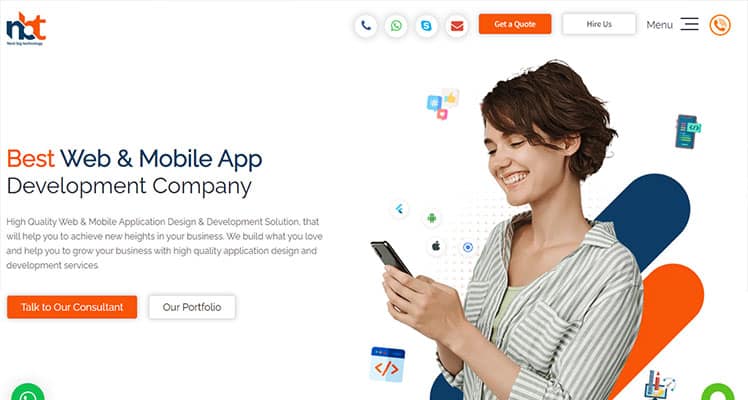Table of Contents
Membership portal development for associations Services
In the digital age, associations are continually seeking innovative ways to connect with their members, streamline operations, and foster a sense of community. One such avenue that has gained significant traction is the development of membership portals tailored to the specific needs of associations. These portals serve as centralized platforms where members can access resources, engage in discussions, register for events, and more. With the right membership portal development services, associations can unlock a myriad of benefits that contribute to their growth and success.
Understanding the Need
Associations, whether professional, trade-based, or community-oriented, thrive on effective communication and member engagement. However, traditional methods of communication, such as emails and newsletters, often fall short in delivering personalized and interactive experiences. This is where membership portals come into play. By providing a digital space dedicated to members, associations can offer a seamless and immersive experience that caters to individual preferences and interests.
Tailored Solutions for Associations
Membership portal development services recognize the unique requirements of associations and offer tailored solutions to address them effectively. These services typically begin with a thorough assessment of the association’s goals, audience demographics, and existing infrastructure. Based on this analysis, developers create customized portals equipped with features like:
- Member Profiles and Directories: A comprehensive member directory allows individuals to create profiles, network with peers, and establish professional connections within the association.
- Resource Libraries: Centralized repositories for documents, research papers, and educational materials enable members to access valuable resources conveniently.
- Event Management Tools: From registration and ticketing to event calendars and reminders, integrated event management tools simplify the planning and execution of association events.
- Discussion Forums and Collaboration Spaces: Interactive forums and collaboration spaces foster meaningful discussions, knowledge sharing, and collaboration among members.
- Communication Channels: Instant messaging, newsletters, and announcement boards facilitate real-time communication and keep members informed about important updates and initiatives.
- Member Engagement Analytics: Built-in analytics tools provide insights into member engagement levels, content consumption patterns, and areas for improvement, empowering associations to refine their strategies effectively.
The Impact of Membership Portals
The implementation of a robust membership portal can have a transformative impact on associations:
- Enhanced Member Experience: By providing members with easy access to resources, events, and networking opportunities, portals enhance overall member satisfaction and loyalty.
- Increased Efficiency: Streamlined processes, automated tasks, and centralized data management improve operational efficiency and reduce administrative burdens for association staff.
- Greater Community Engagement: Interactive features such as discussion forums and collaboration spaces foster a sense of belonging and encourage active participation within the association community.
- Data-Driven Decision Making: Access to comprehensive analytics empowers associations to make data-driven decisions, identify trends, and tailor their offerings to meet evolving member needs.
How to Create a Membership portal development for associations
In today’s digital age, associations are increasingly recognizing the value of establishing a robust online presence to enhance member engagement and streamline administrative processes. One effective way to achieve this is by developing a membership portal tailored to the specific needs of your association. A well-designed portal not only provides members with convenient access to resources and services but also enables administrators to efficiently manage memberships and communication. In this guide, we’ll walk you through the essential steps to create a membership portal that meets the unique requirements of your association.
- Define Your Objectives: Before diving into the development process, it’s crucial to clearly define the objectives and goals of your membership portal. Identify the specific features and functionalities you want to include, such as member directories, event registrations, discussion forums, resource libraries, and online payment options. Understanding your association’s needs will guide the development process and ensure that the portal aligns with your strategic objectives.
- Choose the Right Platform: Selecting the appropriate platform for your membership portal is a critical decision. Consider factors such as scalability, customization options, security features, and ease of integration with existing systems. Popular options include content management systems (CMS) like WordPress, Drupal, or Joomla, as well as dedicated membership management software such as Wild Apricot, MemberClicks, or YourMembership. Evaluate each platform based on your specific requirements before making a decision.
- Design a User-Friendly Interface: The success of your membership portal hinges on its usability and user experience. Invest time in designing an intuitive interface that is easy to navigate and visually appealing. Ensure that important features are prominently displayed, and use clear calls-to-action to guide members through the portal. Consider conducting usability testing with a sample group of members to gather feedback and make necessary improvements before launching the portal to the wider audience.
- Customize Membership Features: Tailor the membership features of your portal to meet the diverse needs of your association’s members. Implement secure registration and login processes, allowing members to create profiles and update their information easily. Offer different membership levels or subscription plans with corresponding benefits and privileges. Provide access to exclusive content, member-only events, and networking opportunities to enhance the value proposition for your members.
- Integrate Communication Tools: Effective communication is essential for fostering engagement and building a sense of community within your association. Integrate communication tools such as email newsletters, discussion forums, and messaging systems directly into your membership portal. Enable members to interact with each other, share insights and resources, and collaborate on projects. Regularly update members with relevant news, announcements, and event invitations to keep them informed and engaged.
- Implement Secure Payment Processing: If your association offers paid memberships or accepts online payments for events or services, prioritize security when implementing payment processing functionality. Choose a trusted payment gateway provider that complies with industry standards for data security, such as PCI DSS (Payment Card Industry Data Security Standard). Encrypt sensitive financial information and ensure that transactions are conducted over a secure connection (HTTPS) to protect member data from unauthorized access or fraud.
- Test and Iterate: Before officially launching your membership portal, conduct thorough testing to identify and address any bugs, glitches, or usability issues. Test the portal across different devices and browsers to ensure compatibility and responsiveness. Solicit feedback from a group of beta testers or pilot users and incorporate their suggestions into the final version of the portal. Once launched, continue to monitor user feedback and analytics data to identify areas for improvement and iterate on the portal over time.
Why Should You Go for Membership portal development for associations
In today’s digitally driven world, associations face a unique set of challenges in engaging their members effectively. With the rise of remote work and virtual communities, the need for robust online platforms has become more critical than ever. This is where membership portal development steps in as a powerful solution that can revolutionize the way associations connect with their members. Let’s delve into why investing in a membership portal is a strategic move for associations looking to thrive in the digital age.
Enhancing Member Experience: One of the primary reasons to opt for membership portal development is to enhance the overall member experience. A well-designed portal serves as a centralized hub where members can access a wealth of resources, participate in discussions, register for events, and interact with fellow members. By providing easy access to valuable content and fostering meaningful connections, associations can strengthen member loyalty and engagement.
Streamlining Administrative Processes: Managing membership data, event registrations, and communication can be overwhelming without the right tools in place. Membership portals streamline administrative processes by automating tasks such as member onboarding, renewals, and event registrations. This not only saves time and resources but also ensures accuracy and consistency in data management, leading to smoother operations for the association.
Personalized Engagement: Personalization is key to delivering a tailored experience that resonates with members. Membership portals allow associations to collect data and insights about member preferences, behavior, and interests. Armed with this information, associations can deliver personalized content, recommendations, and communications that speak directly to each member’s needs and preferences, fostering a deeper sense of connection and relevance.
Driving Revenue and Growth: A well-executed membership portal can also be a powerful revenue-generating tool for associations. By offering premium content, certifications, or exclusive access to resources through subscription-based models, associations can create additional revenue streams while providing enhanced value to members. Furthermore, a user-friendly portal can attract new members and sponsors, driving growth and expanding the association’s reach.
Strengthening Community and Collaboration: Building a strong sense of community and fostering collaboration among members is essential for the long-term success of any association. Membership portals serve as virtual gathering spaces where members can connect, share insights, and collaborate on initiatives. Features such as discussion forums, interest groups, and networking opportunities facilitate meaningful interactions and knowledge sharing, strengthening the association’s community fabric.
Adapting to Changing Needs: In a rapidly evolving landscape, associations must be agile and adaptable to stay relevant. Membership portals offer the flexibility to evolve and adapt to changing member needs, technological advancements, and industry trends. Whether it’s integrating new communication channels, implementing innovative features, or scaling the platform to accommodate growth, a well-designed portal provides the agility needed to future-proof the association’s digital presence.
Market Prospects of Custom Membership portal development for associations and Platforms
In today’s digitally driven world, associations and platforms are continually seeking innovative ways to engage their members and enhance their overall experience. One such avenue that has gained significant traction is the development of custom membership portals tailored to the specific needs of these organizations. These portals serve as centralized hubs where members can access exclusive content, connect with peers, and leverage various resources offered by the association or platform.
The market prospects for custom membership portal development are undeniably promising, driven by several key factors:
- Growing Demand for Personalized Experiences: In an era where personalization is paramount, associations and platforms recognize the importance of offering tailored experiences to their members. Custom membership portals allow them to cater to individual preferences, interests, and needs, thereby fostering deeper engagement and loyalty.
- Streamlined Communication and Collaboration: Effective communication and collaboration are essential for the success of any association or platform. Custom portals facilitate seamless interaction among members, enabling them to share insights, collaborate on projects, and exchange valuable information in real-time.
- Enhanced Member Retention and Acquisition: By providing members with access to exclusive content, networking opportunities, and personalized services, custom portals play a pivotal role in retaining existing members and attracting new ones. The value proposition offered by these portals serves as a compelling incentive for individuals to join and remain active within the community.
- Data-Driven Insights and Analytics: Custom membership portals are equipped with robust analytics capabilities that enable associations and platforms to gain valuable insights into member behavior, preferences, and engagement patterns. By leveraging this data, organizations can make informed decisions, optimize their offerings, and tailor their strategies to better meet the needs of their members.
- Monetization Opportunities: Beyond serving as a means of engagement and communication, custom membership portals present lucrative monetization opportunities for associations and platforms. Through features such as premium content, subscription models, and sponsored partnerships, organizations can generate additional revenue streams while delivering enhanced value to their members.
- Adaptability and Scalability: Custom membership portals are designed to be highly adaptable and scalable, allowing organizations to evolve and expand their offerings over time. Whether catering to a niche industry association or a global professional network, these portals can be customized to accommodate varying needs, preferences, and growth trajectories.
Essential Features of a Membership portal development for associations
In the digital age, associations rely heavily on membership portals to streamline operations, engage members, and foster community. A well-designed membership portal serves as the backbone of an association’s online presence, offering members access to valuable resources, networking opportunities, and exclusive content. However, to truly maximize the benefits of a membership portal, associations must ensure it includes essential features tailored to their unique needs. Let’s delve into the key features that should be incorporated into a membership portal for associations.
- User-Friendly Interface: The user interface should be intuitive and easy to navigate, ensuring members can quickly find the information they need. Clear navigation menus, a search functionality, and personalized dashboards contribute to a seamless user experience.
- Membership Management Tools: An effective membership portal should include robust membership management tools, allowing administrators to easily onboard new members, process renewals, and manage member profiles. Features such as membership directories, member categories, and membership status tracking enhance administrative efficiency.
- Content Management System (CMS): A CMS empowers associations to regularly update and publish content such as articles, news updates, event announcements, and educational resources. Integration with a CMS enables dynamic content delivery, keeping members informed and engaged.
- Event Management Capabilities: Associations often host events, conferences, and webinars to facilitate networking and professional development. A membership portal should offer comprehensive event management capabilities, including event registration, ticketing, agenda management, and attendee tracking.
- Discussion Forums and Networking Tools: Foster community engagement by incorporating discussion forums, online communities, and networking tools within the membership portal. Members can connect with peers, share insights, and collaborate on projects, strengthening the association’s community.
- Resource Library and Knowledge Repository: Centralize resources such as documents, whitepapers, case studies, and best practices within a searchable repository. A well-organized resource library empowers members to access valuable information and expertise relevant to their industry or profession.
- Customizable Member Profiles: Allow members to create and customize their profiles, showcasing their expertise, interests, and affiliations within the association. Customizable profiles facilitate networking and personalized member experiences.
- Secure Payment Gateway: Facilitate secure online transactions for membership dues, event registrations, and merchandise purchases. Integration with a reliable payment gateway ensures member data is protected and transactions are processed smoothly.
- Analytics and Reporting: Gain valuable insights into member engagement, website traffic, and portal usage through built-in analytics and reporting tools. Data-driven insights enable associations to make informed decisions and optimize the portal for maximum effectiveness.
- Mobile Compatibility: In an increasingly mobile-centric world, ensure the membership portal is fully responsive and compatible with various devices and screen sizes. Mobile accessibility allows members to engage with the association anytime, anywhere, enhancing their overall experience.
Advanced Features Membership portal development for associations
In today’s digitally-driven world, associations are increasingly recognizing the importance of having a robust online presence to engage and retain members effectively. Membership portals have emerged as invaluable tools for associations to streamline operations, enhance member experience, and foster community engagement. However, to stay ahead in this competitive landscape, it’s crucial for associations to leverage advanced features in their membership portal development. Let’s delve into some of these advanced features and their significance:
- Customizable User Profiles: Providing members with the ability to personalize their profiles not only fosters a sense of ownership but also enables associations to gather valuable data. Advanced membership portals allow users to customize their profiles with relevant information, interests, and preferences, facilitating targeted communication and personalized experiences.
- Integrated Communication Tools: Effective communication lies at the heart of member engagement. Advanced membership portals integrate various communication tools such as instant messaging, discussion forums, and email newsletters. These features empower associations to deliver timely updates, facilitate meaningful discussions, and nurture relationships within the community.
- Event Management Functionality: Hosting events is a cornerstone of association activities. Advanced portals come equipped with comprehensive event management functionality, allowing associations to effortlessly plan, promote, and manage events. From online registrations and ticketing to event calendars and attendee tracking, these features streamline the entire event lifecycle.
- Resource Library and Content Management: Associations often produce valuable resources such as whitepapers, research reports, and educational materials. Advanced membership portals include robust content management systems (CMS) and searchable libraries, enabling associations to organize, store, and distribute resources effectively. This not only adds value to membership but also positions the association as a trusted source of industry insights.
- Integration with Learning Management Systems (LMS): Continuous learning and professional development are key priorities for association members. Integration with LMS allows associations to offer online courses, training modules, and certification programs directly through the membership portal. This seamless integration enhances member value proposition and encourages ongoing engagement.
- Data Analytics and Reporting: Informed decision-making is essential for association growth and sustainability. Advanced membership portals offer built-in analytics and reporting tools that provide valuable insights into member behavior, engagement metrics, and content performance. By leveraging data-driven insights, associations can refine their strategies, optimize member experiences, and drive organizational success.
- Mobile Accessibility and Responsive Design: With the proliferation of smartphones and tablets, members expect seamless access to association resources anytime, anywhere. Advanced portals feature responsive design and mobile-friendly interfaces, ensuring optimal user experience across devices. Mobile accessibility empowers members to stay connected, access resources on-the-go, and participate actively in association activities.
Membership portal development for associations Timelines
In today’s digital age, associations thrive on connectivity and engagement. A membership portal serves as the backbone of these organizations, facilitating seamless communication, efficient management, and enhanced member experiences. However, embarking on the journey of developing a membership portal requires careful planning and adherence to timelines to ensure success. Let’s delve into the essential timeline for developing a membership portal for associations.
- Pre-Development Phase (1-2 Months): Before diving into development, it’s crucial to conduct a comprehensive assessment of your association’s needs and objectives. Define your goals, target audience, and desired features for the portal. Collaborate with key stakeholders, including board members, staff, and potential users, to gather insights and align expectations. Additionally, conduct market research to identify trends, competitor offerings, and best practices in membership portal development.
- Planning and Requirements Gathering (1 Month): Once you have a clear understanding of your objectives, begin outlining the project scope, budget, and timeline. Work closely with your development team or vendor to define technical requirements, such as platform selection, integration needs, security protocols, and scalability options. Prioritize features based on their importance and feasibility within the allotted resources.
- Design Phase (2-3 Months): Design plays a pivotal role in shaping the user experience of your membership portal. Begin by creating wireframes and prototypes to visualize the layout, navigation flow, and functionality of the portal. Focus on creating an intuitive interface that enhances usability and encourages member engagement. Seek feedback from stakeholders and conduct usability testing to iterate on the design until it meets expectations.
- Development and Testing (3-4 Months): With the design finalized, proceed to the development phase, where your vision starts taking shape. Break down the project into manageable tasks and allocate resources accordingly. Adopt an agile development approach to iteratively build and test features, ensuring that each component meets quality standards and aligns with the established requirements. Conduct thorough testing across different devices, browsers, and user scenarios to identify and address any bugs or usability issues.
- Integration and Deployment (1-2 Months): As development nears completion, focus on integrating the membership portal with existing systems and third-party tools, such as CRM software, payment gateways, and communication platforms. Conduct rigorous compatibility testing to ensure seamless data exchange and functionality across integrated systems. Once integration is successful, plan the deployment strategy, including data migration, user training, and rollout schedules.
- Post-Launch Optimization (Ongoing): The launch of your membership portal is just the beginning of its lifecycle. Continuously monitor user feedback, performance metrics, and usage patterns to identify areas for improvement and optimization. Regularly update the portal with new features, content, and enhancements to keep it relevant and engaging for members. Stay attuned to evolving technologies and user preferences to adapt and innovate over time.
How Much Does It Cost to Membership portal development for associations?
In today’s digital age, associations are increasingly recognizing the importance of having a robust online presence to engage their members effectively. A membership portal serves as a centralized platform where members can access resources, connect with peers, and participate in various activities. However, one common question that arises is, “How much does it cost to develop a membership portal for associations?” Let’s delve into this topic to understand the factors influencing the cost and how associations can budget effectively for this endeavor.
- Scope and Features: The cost of developing a membership portal largely depends on the scope and complexity of features desired. Basic features may include member registration, profile management, event calendars, discussion forums, and document repositories. More advanced features such as online payments, certification tracking, member directories, and analytics capabilities will naturally increase development costs.
- Customization Needs: Associations often have unique requirements based on their niche and member demographics. Customizing the portal to align with these specific needs will impact the overall cost. Tailoring the user interface, integrating with existing systems (such as CRM or email marketing platforms), and implementing branding elements contribute to customization expenses.
- Technical Complexity: The complexity of the technology stack required for the portal also influences costs. Factors such as the choice of development framework, database architecture, security measures, and scalability requirements play a significant role. Integrating third-party plugins or APIs to enhance functionality may incur additional expenses.
- Design and User Experience: A well-designed and intuitive user interface is essential for member engagement. Investing in professional design services and user experience (UX) testing ensures a seamless browsing experience, which can affect development costs. Responsive design for mobile devices and accessibility compliance may also contribute to design expenses.
- Maintenance and Support: Building a membership portal is not a one-time expense; ongoing maintenance and support are crucial for its long-term success. Factoring in costs for software updates, bug fixes, server hosting, and user support services is essential. Associations may choose between in-house maintenance teams or outsourcing to third-party vendors, each with its associated costs.
- Regulatory Compliance: Depending on the nature of the association and its geographical location, regulatory compliance requirements such as data protection (e.g., GDPR), accessibility standards, and industry-specific regulations must be considered. Ensuring compliance adds an extra layer of cost to the development process.
- Scalability and Future Growth: Anticipating future growth and scalability needs is vital to avoid costly redesigns or migrations down the line. Investing in a flexible architecture that can accommodate increasing membership numbers and evolving features mitigates the risk of outgrowing the portal prematurely.
How to Create a Membership portal development for associations – Team and Tech Stack
In today’s digital era, associations are leveraging technology to streamline their operations and enhance member engagement. One such technological advancement is the creation of membership portals tailored to the unique needs of associations. These portals serve as centralized platforms where members can access resources, communicate with peers, and participate in various activities. However, developing a membership portal requires careful planning, a skilled team, and the right technological tools. In this guide, we’ll delve into the essential aspects of creating a membership portal for associations, including the required team and the optimal tech stack.
Understanding the Purpose and Audience
Before diving into development, it’s crucial to understand the purpose of the membership portal and the needs of the association’s members. Conducting surveys or interviews with stakeholders can provide valuable insights into the features and functionalities required. Whether it’s facilitating communication, providing access to exclusive content, or managing memberships, a clear understanding of the portal’s purpose will guide the development process.
Building the Right Team
Creating a membership portal is a collaborative effort that involves various skills and expertise. Here are the key roles that should be part of your development team:
- Project Manager: Oversees the entire development process, ensures timely delivery, and coordinates with stakeholders.
- UI/UX Designer: Designs an intuitive and user-friendly interface, keeping the end user in mind.
- Frontend Developer: Implements the designs using HTML, CSS, and JavaScript, ensuring responsiveness across devices.
- Backend Developer: Builds the core functionality of the portal, manages databases, and implements security measures.
- Quality Assurance (QA) Tester: Conducts rigorous testing to identify and fix any bugs or usability issues.
- Content Manager: Responsible for curating and managing the content available on the portal, ensuring relevance and accuracy.
- SEO Specialist: Optimizes the portal’s content and structure to improve visibility and rankings on search engines.
Choosing the Right Tech Stack
Selecting the appropriate technologies is crucial for the performance, scalability, and security of the membership portal. Here’s a recommended tech stack for building a robust portal:
- Frontend Technologies:
- HTML5, CSS3, JavaScript (for interactivity)
- React.js or Angular.js (for building dynamic user interfaces)
- Bootstrap or Materialize (for responsive design)
- Backend Technologies:
- Node.js, Python, or Ruby on Rails (for server-side logic)
- Express.js, Django, or Flask (for building web applications)
- MongoDB, MySQL, or PostgreSQL (for database management)
- Security Measures:
- Implement HTTPS protocol for secure communication.
- Use encryption techniques to protect sensitive data.
- Regularly update software and patch vulnerabilities.
- Integration and APIs:
- Integrate with payment gateways for managing memberships and subscriptions.
- Utilize APIs for seamless integration with other systems, such as CRM or email marketing platforms.
Membership portal development for associations Process
In today’s digital age, associations are continuously seeking innovative ways to enhance their member engagement and streamline administrative processes. One such solution gaining popularity is the development of membership portals tailored to the specific needs of associations. These portals serve as centralized platforms where members can access resources, communicate with fellow members, and participate in various activities, all while providing administrators with efficient tools to manage memberships and facilitate organizational tasks.
Understanding the Process of Membership Portal Development
1. Needs Assessment: The first step in membership portal development is conducting a comprehensive needs assessment. This involves identifying the specific requirements and objectives of the association, as well as understanding the expectations of its members. By gathering input from key stakeholders, such as board members and staff, associations can ensure that the portal addresses their unique challenges and goals.
2. Planning and Strategy: Once the requirements are identified, a detailed plan and strategy are formulated to guide the development process. This includes defining the features and functionalities of the portal, establishing a timeline, and allocating resources accordingly. A well-defined strategy ensures that the development process progresses smoothly and efficiently.
3. Design and Development: The design phase involves creating an intuitive and user-friendly interface that aligns with the association’s branding and enhances the overall user experience. Development teams utilize various technologies and frameworks to build the portal, ensuring scalability, security, and compatibility with different devices and browsers.
4. Content Integration: Content integration plays a crucial role in ensuring that the portal delivers value to its users. This includes uploading relevant resources such as documents, articles, and multimedia content, as well as configuring access permissions based on membership levels or roles within the association.
5. Testing and Quality Assurance: Before launching the portal, rigorous testing and quality assurance procedures are conducted to identify and address any issues or bugs. This involves testing the portal’s functionality, performance, and security measures to ensure a seamless user experience and data integrity.
6. Launch and Deployment: Once testing is complete and any necessary adjustments are made, the portal is ready for launch. A strategic deployment plan is executed to minimize disruption and ensure a smooth transition for members and administrators alike. Post-launch support and training are provided to help users navigate the portal effectively.
Benefits of Membership Portals for Associations
1. Enhanced Member Engagement: Membership portals provide members with convenient access to resources, events, and networking opportunities, fostering greater engagement and participation within the association.
2. Streamlined Administrative Processes: By automating tasks such as membership renewals, event registrations, and communication management, portals reduce the administrative burden on association staff, allowing them to focus on strategic initiatives.
3. Improved Communication and Collaboration: Portals facilitate seamless communication and collaboration among members through features such as discussion forums, messaging, and document sharing, promoting knowledge exchange and community building.
4. Data-driven Decision Making: Portals generate valuable insights through analytics and reporting tools, enabling associations to make informed decisions based on member behavior, preferences, and feedback.
5. Scalability and Adaptability: Membership portals are designed to scale and adapt to the evolving needs of associations, accommodating growth, and incorporating new features and functionalities as needed.
Next Big Technology – Your Trusted Membership portal development for associations Partner
In today’s fast-paced digital world, associations and organizations are constantly seeking innovative solutions to streamline their operations and enhance member engagement. One such solution that is gaining momentum is the development of membership portals tailored to meet the unique needs of each association. As associations look to embrace the digital transformation, finding a trusted partner for membership portal development becomes paramount. Enter Next Big Technology, a leading name in the tech industry, poised to revolutionize association management with its cutting-edge solutions.
Next Big Technology understands that every association is unique, with its own set of goals, challenges, and member demographics. Therefore, they don’t offer one-size-fits-all solutions but instead, work closely with each client to develop customized membership portals that align perfectly with their vision and requirements.
What sets Next Big Technology apart is their unwavering commitment to excellence and customer satisfaction. With a team of experienced developers, designers, and project managers, they ensure that every aspect of the membership portal is meticulously crafted to deliver a seamless user experience. From intuitive navigation to responsive design, they leave no stone unturned in creating portals that captivate and engage members.
Moreover, Next Big Technology understands the importance of scalability and future-proofing. Their membership portals are built on robust and flexible platforms that can easily adapt to the evolving needs of the association. Whether it’s adding new features, integrating third-party tools, or accommodating a growing membership base, their portals are designed to grow with the association.
Security is another area where Next Big Technology excels. They employ the latest encryption technologies and best practices to safeguard sensitive member data and ensure compliance with industry regulations. Associations can rest assured knowing that their members’ information is protected against cyber threats and unauthorized access.
But perhaps what truly sets Next Big Technology apart is their collaborative approach to partnership. They don’t just see themselves as vendors but as trusted advisors, dedicated to helping associations achieve their goals and maximize their impact. From the initial consultation to post-launch support, they are there every step of the way, providing guidance, insights, and technical expertise.
Enterprise Membership portal development for associations
In today’s digitally-driven world, associations are constantly seeking innovative ways to streamline operations, enhance member engagement, and deliver value. One such solution that has gained significant traction is the development of enterprise membership portals tailored specifically for associations. These portals serve as centralized platforms where members can access a plethora of resources, interact with one another, and stay updated on industry news and events. In this article, we delve into the significance of enterprise membership portal development for associations, its key features, and the benefits it offers.
Understanding Enterprise Membership Portals:
Enterprise membership portals are comprehensive online platforms designed to cater to the unique needs of associations, whether they are professional organizations, trade associations, or nonprofits. These portals are more than just repositories of information; they are dynamic ecosystems that facilitate seamless communication, collaboration, and resource sharing among members. From event management and content distribution to online forums and member directories, these portals encompass a wide array of functionalities aimed at fostering a sense of community and adding value to membership.
Key Features of Enterprise Membership Portals:
- Member Profiles and Directories: Enable members to create personalized profiles, connect with peers, and access a centralized directory to locate and network with other professionals within the association.
- Content Management System (CMS): Empower associations to curate and distribute relevant content such as articles, whitepapers, and industry reports, keeping members informed about the latest trends and developments.
- Event Management: Facilitate the planning, promotion, and registration of events, conferences, and webinars, allowing members to RSVP and access event-related resources conveniently.
- Discussion Forums and Online Communities: Provide dedicated spaces for members to engage in discussions, share insights, and seek advice from peers, fostering knowledge exchange and collaboration.
- Resource Library: Centralize a repository of documents, templates, and educational materials for easy access, enabling members to enhance their skills and stay updated on best practices.
- Membership Renewal and Payments: Simplify the membership renewal process through online portals, allowing members to conveniently renew their subscriptions and make payments securely.
- Analytics and Reporting: Offer insights into member engagement, event attendance, and content consumption patterns, empowering associations to make data-driven decisions and optimize their strategies.
Benefits of Enterprise Membership Portals:
- Enhanced Member Engagement: By providing a platform for networking, collaboration, and knowledge sharing, enterprise membership portals foster a sense of belonging and encourage active participation among members.
- Improved Operational Efficiency: Automation of administrative tasks such as event management and membership renewals reduces manual workload, freeing up resources to focus on strategic initiatives.
- Increased Revenue Generation: With features such as online event registrations and membership renewals, associations can streamline revenue collection processes and potentially attract new members through enhanced user experience.
- Data-driven Decision Making: Robust analytics capabilities enable associations to gain valuable insights into member preferences and behaviors, enabling them to tailor their offerings and communication strategies accordingly.
- Scalability and Adaptability: Enterprise membership portals are designed to scale alongside the association’s growth and adapt to evolving needs, ensuring long-term relevance and sustainability.
Top Membership portal development for associations Companies
In today’s dynamic business landscape, associations and companies alike are constantly seeking innovative ways to streamline their operations, engage members, and foster meaningful connections. One powerful solution that has emerged to meet these needs is membership portal development. These portals serve as centralized platforms where organizations can manage memberships, offer exclusive content, facilitate communication, and drive collaboration. Choosing the right membership portal development service is crucial for maximizing efficiency and achieving organizational goals. Here, we explore some of the top options available for associations and companies.
-
-
Next Big Technology:
Next Big Technology is one of the top development companies for the high-quality development of mobile apps and web development services. They have having experienced in-house team of developers who provide top-notch development services according to the business requirements. NBT provides highly business-oriented services and implements all the latest and trending tools and technologies. They always work hard to deliver a top-notch solution at an affordable cost. They are having experience of more than 13 years and delivered lots of projects around the globe to businesses and clients.
NBT is highly focused on providing top-notch development solutions at a very affordable cost. By using their market experience and development experience, they are delivering proper solutions to clients and various industries for their custom requirements.
Location: India, USA, UK, Australia
Hourly Rate :< $25 per Hour
Employees: 50 – 249
Focus Area
- Mobile App Development
- App Designing (UI/UX)
- Software Development
- Web Development
- AR & VR Development
- Big Data & BI
- Cloud Computing Services
- DevOps
- E-commerce Development
Industries Focus
- Art, Entertainment & Music
- Business Services
- Consumer Products
- Designing
- Education
- Financial & Payments
- Gaming
- Government
- Healthcare & Medical
- Hospitality
- Information Technology
- Legal & Compliance
- Manufacturing
- Media
-
- MemberClicks: MemberClicks is another leading provider of membership portal solutions, renowned for its comprehensive feature set and intuitive interface. From membership management and event registration to email marketing and reporting, MemberClicks offers a robust suite of tools designed to streamline operations and enhance member engagement. With flexible pricing plans and responsive customer support, MemberClicks caters to organizations of all sizes.
- Membee: For associations seeking a highly customizable membership portal solution, Membee is an excellent option. With its modular design and extensive integration capabilities, Membee enables organizations to tailor their portals to suit their unique needs and workflows. Whether managing memberships, processing payments, or analyzing member data, Membee provides the flexibility and scalability required for long-term success.
- YourMembership: YourMembership, part of the Community Brands family, offers a comprehensive suite of membership management solutions tailored for associations and chambers of commerce. With features such as online communities, learning management, and career centers, YourMembership goes beyond basic portal functionality to deliver a holistic engagement experience for members. Backed by robust security measures and dedicated support, YourMembership provides peace of mind for organizations handling sensitive member data.
- Glue Up (formerly EventBank): Glue Up is a versatile platform that combines membership management, event planning, and CRM into a single integrated solution. Ideal for associations and professional networks seeking to centralize their operations, Glue Up offers a range of features including member directories, event ticketing, and automated communications. With its cloud-based architecture and mobile-friendly interface, Glue Up empowers organizations to stay connected with members anytime, anywhere.
FAQs on Membership portal development for associations
In today’s digital age, membership portals have become indispensable tools for associations looking to streamline their operations and enhance member engagement. These platforms offer a centralized hub where members can access resources, network with peers, and stay updated on relevant information. However, navigating the realm of membership portal development can raise numerous questions. Let’s delve into some frequently asked questions (FAQs) to shed light on this topic:
- What is a membership portal, and why do associations need one? A membership portal is a secure online platform that serves as a central hub for association members. It provides them with access to exclusive content, resources, event registrations, and communication channels. Associations benefit from membership portals by fostering stronger member connections, improving communication, and efficiently managing their operations.
- What features should a membership portal include? While the specific features may vary based on the association’s needs, essential components of a membership portal typically include member directories, event calendars, discussion forums, document repositories, and secure member communication channels. Integration with payment processing systems and analytics tools is also valuable for tracking member engagement and portal performance.
- How can associations ensure data security and privacy within the portal? Data security is paramount for membership portals, considering the sensitive information they often handle. Associations should implement robust security measures such as encryption, secure user authentication protocols, regular security audits, and compliance with relevant data protection regulations like GDPR or CCPA. Additionally, providing members with clear privacy policies and control over their data enhances trust and transparency.
- Is it necessary to customize the portal according to our association’s branding and requirements? Customization plays a crucial role in ensuring that the membership portal aligns with the association’s branding, goals, and unique needs. Tailoring the portal’s design, layout, features, and content not only enhances the user experience but also reinforces the association’s identity and value proposition. Working with experienced developers who understand the association’s objectives is essential for effective customization.
- How can associations encourage member engagement through the portal? Member engagement is key to the success of a membership portal. Associations can foster engagement by regularly updating content, facilitating discussions and collaboration among members, offering interactive features such as polls or surveys, and providing personalized recommendations based on member interests and activities. Incorporating gamification elements and recognition programs can also incentivize participation.
- What ongoing maintenance and support are required for a membership portal? Like any digital platform, membership portals require ongoing maintenance, updates, and technical support to ensure optimal performance and security. This may include software updates, bug fixes, content management, user support, and monitoring for any emerging issues or security threats. Associations should establish clear procedures for handling maintenance tasks and providing timely support to members.
- How can associations measure the effectiveness of their membership portal? Tracking key performance indicators (KPIs) is essential for evaluating the effectiveness of a membership portal. KPIs may include metrics such as member engagement levels, portal traffic, event registrations, content consumption patterns, and member satisfaction surveys. Regularly analyzing these metrics allows associations to identify areas for improvement and refine their portal strategy accordingly.
Thanks for reading our post “Membership portal development for associations”. Please connect with us to learn more about the Membership portal development.

















